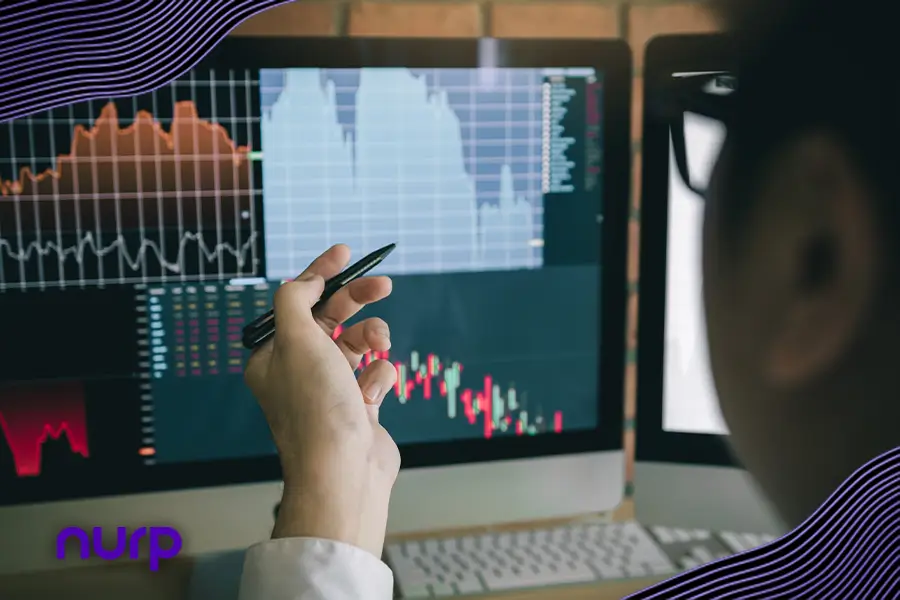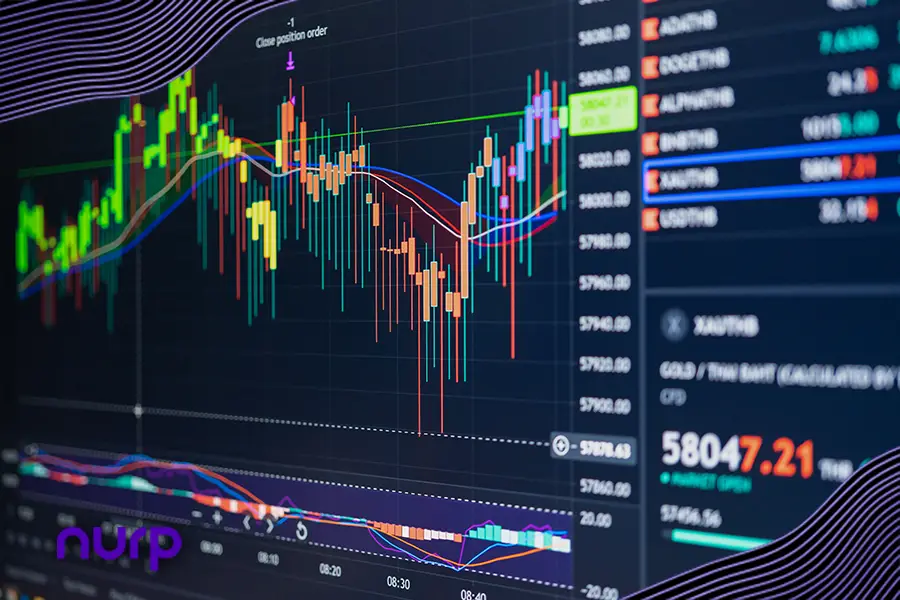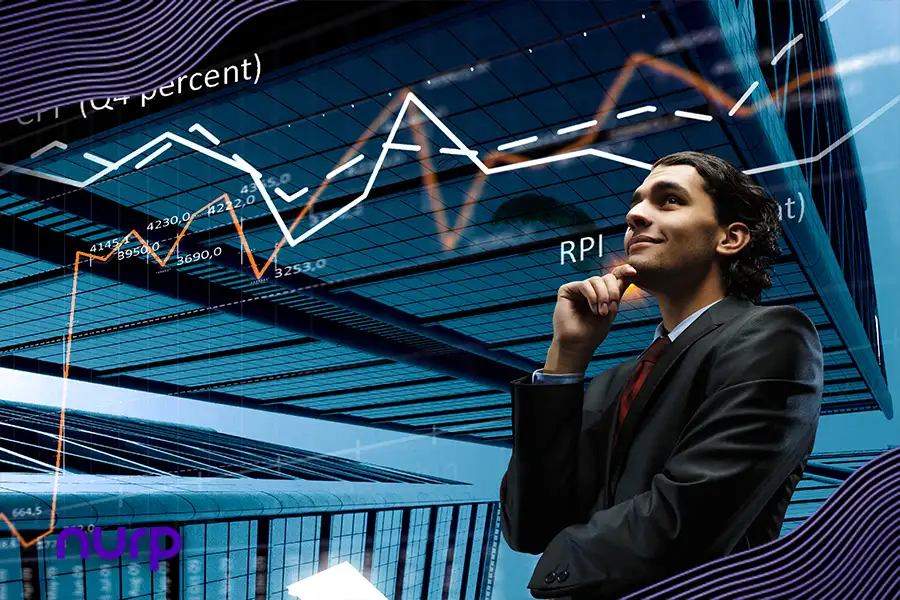Matt Jimenez: Welcome to the channel. Today, I have Jeff Sekinger joining us yet for another episode, and today we’re going to be going over some of the myths within the algorithmic trading industry and more so the ideologies around it. I believe a lot of people get into this space and they believe that it’s just passive income, and they can do whatever they want and let these trading algorithm softwares run effortlessly. So today, I want you to share a little bit of the reality in this sector. What would you say to the people getting into any algorithmic trading company, let alone Nurp, and having the understanding that it’s just passive income?
Jeff Sekinger: The first thing I would say is, there’s no such thing as 100% passive income. A lot of the algorithmic trading strategies that we use do take the majority of the work away from the trader, so that the trader is just making sure that the account is functioning and the strategy is functioning how it’s supposed to. They do need to monitor the accounts because, at the end of the day, it’s their own money trading in a market, and no one can predict what the market’s going to do.
Since you don’t know what the market’s going to do, there can be things that randomly happen that can throw off a strategy, and that’s when you need to be paying more attention to your account. So, I would say that’s number one – you know, nothing is truly 100% passive.
If someone else is managing your account and they don’t have a license, or you’re not in a legitimate hedge fund, and you haven’t signed a PPM and subscription documents and things that typical hedge funds have, they’re probably – especially if you’re operating in the U.S. – they’re probably not operating legally.
I’ve heard about a lot of different companies managing other accounts for their users, and that’s just completely not legal. So if that’s the case, that’s still active management on behalf of you by whoever their employee is. So that would be number one.
And then number two, it’s still a high-risk vehicle. So it’s important to understand that any type of trading and any type of investment that has leverage increases the degree of risk. Some people see crazy returns in algorithmic trading – which we’ve experienced some awesome months before – and they think that’s going to be the return for eternity, or that there’s no risk behind that.
What you’ve got to realize is it is considered high-risk, and it’s important to understand in your entire portfolio what percentage of your portfolio you want in algorithmic trading or something that’s high-risk. You never want to just throw your whole portfolio into something that is completely high-risk. It’s important for an investor to prudently look at their allocation and say, “Okay, I want 2%, 5%, 10% of my portfolio in high-risk investments.” Maybe it’s crypto and algorithmic trading—that’s what it is for me. The two high-risk investments I have are algos and crypto, but I’m not throwing all of my money into one of them because they’re considered high-risk investments.
Matt Jimenez: I understand all of that, but for the people, why do they feel that they could just use this as a passive income tool?
Jeff Sekinger: I think just because of maybe not understanding algorithms for the most part. They hear “algorithmic trading,” and the algorithm executes—like, we’ve had accounts that have executed tens of thousands of trades with no human intervention. That is reality, but at the same point in time, there are certain things that happen in the market that you can’t predict. An account can run for years without you intervening whatsoever, but sometimes there are random events where, yeah, you do need to pay attention.
There are certain times where, yeah, you could let it run for a long time and it could be good. But then there are little things, like MetaTrader rolling out an update, right? Now you need to close the window, redownload the MetaTrader application, restart the window, and get things to update. If you don’t do that, then the algorithm is not going to trade.
So certain things happen – it doesn’t even have to be a move in the market. It could be MetaTrader rolling out an update, and you need to refresh the window. If you don’t, your strategy is going to just sit in those trades and not execute new trades. You have to be attentive to the software because of unforeseeable things.
I guess people feel that it’s passive because sometimes, for large portions of time, they don’t really have to do anything, and they deem that as, “This is what it is, I don’t have to do anything.”
Matt Jimenez: Yeah, okay. So, what are we doing inside of Nurp to make sure that we can educate our people to understand that this is not a passive tool? This is something that can help you optimize your portfolio. Do we have any education or material that we’re going to be rolling out, or what is it that we’re going to provide?
Jeff Sekinger: We’ve had education since day one. That’s always been the cornerstone of almost everything that I’ve done. But as far as our product goes, our core product, ATA, we’ve always had education. We’ve always framed it as, “Hey, this is a tool. This is a tool for you that’s really powerful, but you need to be educated to understand how to use the tool in your own portfolio and in your own account.”
We have a bunch of different risk management videos, how to set up the software, troubleshooting if you have certain issues, and more. Then we have more one-on-one support. We’ve got three open calls a day where clients can just jump into a Zoom call and talk to us directly. We’ve also got relationship managers that clients can reach out to and talk to one-on-one. The community is a huge aspect as well, with thousands of users who are using the software and bouncing ideas off each other.
Additionally, we’ve recently heightened some of our requirements with onboarding. They have to go through certain videos, and then they have to take a small quiz to confirm that they’ve listened to the videos and understand what they meant. This ensures they know how to use the software—how to turn it on and off, where the stop-loss setting is, things like that.
So, yeah, there’s a ton of education and accountability in place to make sure the user knows what they’re doing and how to use the tool.
Matt Jimenez: And on the product side of things, how are we going to be optimizing our software now and moving forward into the future to make sure we have the proper risk parameters for anything that we do?
Jeff Sekinger: Well, all of our strategies have always had a stop-loss since day one. Every single strategy has a default stop-loss, or in the settings, there’s a setting where you just select. You check one thing from “false” to “true,” which enables the equity stop-loss. You turn that to “true” and then just type in whatever percentage you’re comfortable with as your stop-loss.
For example, let’s say you have a $100,000 account, and you turn that setting to “true” and type in 30, which represents 30%. So when the account draws down by 30%, it will close all the trades and get you out completely. That way, if something crazy happens—like random news or a major event – you’re out of the trade. You might take a 30% loss, but you’re protecting the rest of the account.
That’s always been in there, but it’s important to note that there’s no secret number for the best stop-loss. There’s no “best” at 10%, 20%, or 50%. It depends on so many different market dynamics. For example, in a ranging market, you can have a tighter stop-loss, but in a trending market, you need a much wider stop-loss. That also increases risk because trending markets typically have more drawdowns. It all depends on the type of market, which is determined by things like trade deficits, CPI, inflation, interest rates, and so on.
So yeah, the power is ultimately in the hands of the user. For me, on my accounts, I usually set the stop-losses to 40% or 50%. For lower account sizes, when I’m trying to be more aggressive, I don’t have a stop-loss on those accounts because, essentially, the whole account is the stop-loss. I have so many different accounts, so I’m not worried if I lose a $30,000 account. I’m willing to risk that entire $30,000 because I’m trying to push for, you know, 15%, 20%, or 30% a month, which is obviously super high risk. The higher the percentage I’m shooting for, the higher the risk I’m taking, and if I lose the whole account, I’m okay with it because I’ve already accepted that risk.
For some of my bigger accounts, I set stop-losses at 30%, 40%, or 50%, and I’m just aiming for a 4% to 8% type return.
Matt Jimenez: Okay, all right. So, before we go further into this, none of this is ever financial advice. This is just for educational purposes, you know what I’m doing. So essentially, what you’re saying is, let’s say you have $500,000 allocated to multiple software accounts. You’re setting up individual accounts with a certain amount of dollars, and you’re willing to risk that. That’s essentially what your stop-loss would be on the overall $500,000. Like, say you have two or three high-risk accounts with, like, $10K, $30K, and $10K – those are all small accounts you’re willing to put fully at risk?
Jeff Sekinger: Yeah, exactly. Out of a $500,000 pie, because if you think about it, let’s say I have $100,000 in algorithmic trading and I have a $10,000 account that I’m being high-risk with. If I lose that entire account, okay, that’s a 10% loss. I’m okay taking a 10% loss. So, I understand holistically, across my portfolio of strategies, if I completely lose an account, that’s 10% of my total portfolio in algorithmic trading. That is my stop-loss.
Sometimes I have accounts where I’ll try to push harder to get a higher return. Then, for the bigger accounts, I’m like, “I don’t really want to risk $300,000,” so I’ll set a stop-loss at a certain percentage. Does that make sense?
Matt Jimenez: Yeah, yeah, that makes sense. On the product side of things, do we have anything new in the works? Maybe a new product?
Jeff Sekinger: Yeah, I mean, a lot. We have four strategies currently being built behind the scenes that we’re excited about, and we’re seeing a lot of good data so far on them. One of the main things, too, is our machine learning piece. I don’t think you’ve had Pascal on the channel yet, but he’s one of our AI quants. He’s been in machine learning for over a decade. That’s something we’ve been working on for quite a while—figuring out how we can determine trends better, so we’re not getting into situations where, let’s say we have a big trend to the upside, and right before it reverses, we’re putting in a buy. Then it starts to drop, and we need to scale into that through our risk management sequence.
We want to identify trends better based on recent market data, and that’s what machine learning is helping us do. It’s significantly lowering the drawdowns in our backtests. We haven’t live-tested this yet, but in all of the testing, which has taken a fair amount of time, it’s significantly lowered our drawdowns. It has decreased profit a little bit, but not nearly as much on a percentage basis as it has dropped the drawdowns. What that means is, we could increase the size of the trades we’re telling the algorithm to take, and that’s going to increase the profit number. But the drawdown will still be lower because, in proportion to profit and drawdown, that ML filter is dramatically dropping the drawdown.
That’s something we’re working really hard on, and we plan to have it rolled out by the end of the year. I think that’s going to help a lot on the risk management side because the algorithm will get into fewer drawdowns if that makes sense.
Matt Jimenez: Okay, interesting. And then, another thing is, are we developing more trend-following systems?
Jeff Sekinger: Absolutely. The whole market dynamic recently has shifted. Countries are pivoting on interest rates because they’re worried about job numbers, and inflation has come down a bit, so they’re starting to drop rates. Then you have Japan freaking out and increasing rates. We’re seeing countries make really significant decisions. In Japan’s case, it was a 17-year flip on their decision.
In the U.S., we’ve been hiking rates at the fastest pace since 2022, and now the Fed has recently indicated that it’s time to change policy decisions, which means they’re probably going to change the direction of interest rates. So, we’re seeing trending markets. We’ve got two systems in the pipeline that are trend-following systems. They’ll place a trade, put in a stop-loss at a certain level, and allow that trade to ride the trend. It’s aiming for much larger take-profits, instead of small 0.1% or 0.2% moves. It’s aiming for bigger market moves.
Matt Jimenez: How would it identify when it’s in a trend?
Jeff Sekinger: Mainly through the machine learning that we’ve been testing in one of the systems. There are multiple trend filters we use, and we pair three of them together to better identify when a trend is coming. On a fundamental level, the algorithm can also identify things happening within a country relative to another country. Each currency pair is one currency against another. If the country in the numerator is decreasing rates, that pair is going to get a lot weaker. So, if we know that this country is decreasing and another country is increasing rates, we can make decisions based on that.
Matt Jimenez: Okay, so we only want to go short on that pair because it’s very likely that the pair is going to be weak due to the changes in rates. So, it has a fundamental filter to a degree?
Jeff Sekinger: Yeah, yeah.
Matt Jimenez: Nice, amazing. So, we’ve spoken about risk and a few other things. The last thing I wanted to touch on is – again, this is not financial advice – at what point do you recommend yourself to take profits or take anything out of the market? Because you can’t just have the idea of “I’m just going to let it run forever,” right?
Jeff Sekinger: Oh, yeah, absolutely. Since I’ve been doing this for many years, on really any speculative investment, when an investment doubles, triples, or quadruples, I always pull the principal out. I listen to people who are smarter than me. Warren Buffett’s got his two rules: Rule number one, don’t lose money. Rule number two, don’t forget the first rule. Pretty much, he’s saying there’s one rule, and that’s don’t lose money. If you don’t lose money, guess what’s going to happen – you’re probably going to make money.
So, when I take that advice, I say, “Okay, if my account doubles…” If I have a bigger account size, I usually pull the profit out almost every month. Sometimes I skip a month or two, and then I pull a bigger amount the next month. But for the most part, when an account doubles, I’m pulling the initial principal out of that account to protect it. That’s my personal risk management strategy, which I take from a guy like Warren Buffett, who’s smarter and has been in the game longer than me.
You’ll see that on almost all my FX accounts – I consistently keep pulling money out because I know that if I can protect the principal, and I’m playing with house money, your emotions are a lot less involved. In investing and trading, when you know that the money you have in the investment is all profit, you think differently. It’s house money, and when you’re playing with house money, you make fewer emotional decisions.
Another thing I like to do is not only pull principal out but sometimes diversify into a different strategy, so I don’t have one point of failure. I don’t want one point of failure, even with a broker. I’m not going to have all my money in one broker. I spread my money across different brokers and have different strategies with those brokers so I don’t have that one point of failure.
Then, when I double the accounts, I pull the principal out. Depending on where other markets are, sometimes if the crypto market is down, I’ll pull profit out and put it into crypto. Then, when crypto rallies, I might pull some out of there and spin up a new account with a different broker or strategy. It just depends on what’s happening in the market.
But yeah, that’s always been my rule, and I see people who, because I talk about this a lot, say, “That makes so much sense, thanks for sharing.” But then they get too greedy and don’t do it. Then, they hit a drawdown and think, “Man, I really wish I would have done that.” At that point, it’s too late. You just have to be disciplined enough – it’s just like fitness, working out, or your diet. You know what to do, but are you going to do it?
Matt Jimenez: Yeah, that’s true. That’s a good point. Well, I think that’s everything I wanted to cover today. I do want to leave the users and anyone looking to potentially license the software with one question: What can they expect from Nurp in the next 12 to 24 months?
Jeff Sekinger: Here at Nurp, we have internal milestones with all the different things we’re working on. But you can expect to continuously see us building a spectacular team and technology. That’s always my number one focus – how can we make the product better and create a better team? Ultimately, at the end of the day, the business and the product are only as good as the team. That’s why we’ve got machine learning coming into the mix soon.
Matt Jimenez: For sure. I mean, that’s just the beginning.
Jeff Sekinger: Absolutely, and I appreciate you taking the time to hop on here and talk with me and everyone else watching.
Matt Jimenez: Thank you.
Jeff Sekinger: Absolutely, thank you.
Please visit Reality of Algorithmic Trading in Your Portfolio | What to Expect to watch the full interview on YouTube!
The post Reality of Algorithmic Trading in Your Portfolio | What to Expect first appeared on Nurp.com.





